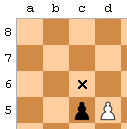en passant
The French expression en passant (abbreviation: e. P. ) Can be translated as in passing, in passing or also casually and describes a special move of a pawn in the game of chess . The foreign word is also used as a phrase outside of chess , for example to designate an activity that can be done on the side without much effort.
In chess, capturing while passing is defined as the ability to move with a pawn to capture an opposing pawn if the pawn moves from the starting position by a double step beyond the capture area of your own pawn. In this case the pawn move is to be evaluated as if it had only taken one step forward from the starting position instead of two. En passant can only be captured immediately after the opposing pawn takes the double step and only by a pawn of your own.
This special rule arose because the pawns were allowed to take a double step from the basic position. At the same time, however, an advanced pawn should not lose its effect of being able to stop an opposing pawn on the starting square or to capture after a move. So it remained attractive to lead an offensive game, as the possibility of opening lines was still given.
In addition, it was assumed that the game of chess shows a form of battle formation, and that in reality an army unit can be defeated if it has advanced a long way after a long march and the opponent is suddenly threatening on the flank. Seen in this way, the peasant defeated en passant also stands for the unit cut off from supply lines, which is not operated in the unit and thus encircled.
example
A black pawn is on d7, a white pawn is on e5. Black moves the pawn in a double step from d7 to d5. White now - but only in the immediately following half-move - has the opportunity to capture this pawn en passant : To do this, the black pawn on d5 is removed from the board, the white pawn moves from e5 to d6.
Notation: e5 x d6 e. p. ( the abbreviation e. p. is usually left out )
Specialty
A technical peculiarity: A double chess without one of the chess-giving pieces moving in the last move is only possible with the en-passant move.
|
Starting position
Black to move |
After double step e7 – e5
White to move |
After e7 – e5 d5xe6 ep
Black to move |
Chess composition
In chess composition , capturing en passant as a key move is only permitted if it can be proven that the last move allows such a blow. Only through en passant is it possible to remove two figures from a row at the same time. Another peculiarity of the field was shown by Korolkow in one of his studies.
Chess 1957
| a | b | c | d | e | f | G | H | ||
| 8th | 8th | ||||||||
| 7th | 7th | ||||||||
| 6th | 6th | ||||||||
| 5 | 5 | ||||||||
| 4th | 4th | ||||||||
| 3 | 3 | ||||||||
| 2 | 2 | ||||||||
| 1 | 1 | ||||||||
| a | b | c | d | e | f | G | H |
After 5. Bc3 – a1 d7 – d6! Black tries to build a stalemate . After 6. c2 – c3? d4 – d3 + the stalemate could no longer be prevented. However, White has the move 6. c2 – c4! who at first glance fails immediately, but at second glance exploits the pawn's peg on d4 and thus forces capturing en passant. After 6 ... d4xc3 ep 7 La1xc3 but black is matte .
Individual evidence
- ^ FIDE Laws of Chess , accessed February 28, 2015
- ↑ Artur Wachelka: Learning chess: en passant. (php) (No longer available online.) In: www.schachtrainer.de. Archived from the original on May 14, 2014 ; accessed on May 13, 2014 .

